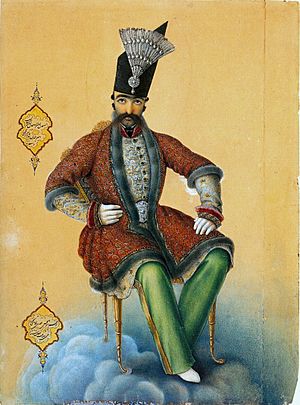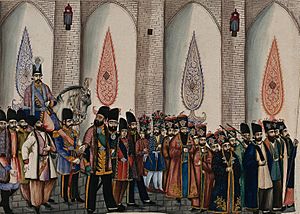Naser al-Din Shah Qajar facts for kids
Quick facts for kids Naser al-Din Shah Qajar |
|||||
|---|---|---|---|---|---|
| Shahanshah of Iran Zell'ollah (Shadow of God [on earth]) Qebleh-ye 'ālam (Pivot of the Universe) Islampanah (Refuge of Islam) |
|||||
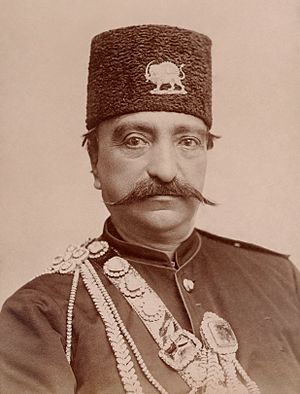
Naser al-Din Shah, photographed by Nadar in 1889
|
|||||
| Shah of Iran | |||||
| Reign | 5 September 1848 – 1 May 1896 | ||||
| Predecessor | Mohammad Shah Qajar | ||||
| Successor | Mozaffar ad-Din Shah Qajar | ||||
| Regent | Malek Jahan Khanom | ||||
| Premiers |
See list
Amir Kabir Mirza Aqa Khan Nuri Mirza Hosein Khan Mirza Yusuf Ashtiani Mirza Ali Asghar Khan |
||||
| Born | 16 July 1831 Kahnamu, Iran |
||||
| Died | 1 May 1896 (aged 64) Tehran, Iran |
||||
| Burial | Shah-Abdol-Azim shrine | ||||
| Spouse | 85 women, among them:
Jeyran
(m. 1851; died 1860)
|
||||
| Issue | See below | ||||
|
|||||
| Dynasty | Qajar | ||||
| Father | Mohammad Shah Qajar | ||||
| Mother | Malek Jahan Khanom | ||||
| Religion | Shia Islam | ||||
| Tughra | 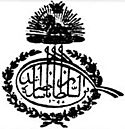 |
||||
Naser al-Din Shah Qajar (Persian: ناصرالدینشاه قاجار, romanized: Nāser-ad-Din Ŝāh-e Qājār; 16 July 1831 – 1 May 1896) was the fourth Shah (king) of Qajar Iran. He ruled from September 5, 1848, until he was assassinated on May 1, 1896. He was the son of Mohammad Shah Qajar and Malek Jahan Khanom.
Naser al-Din Shah was the third longest-reigning monarch in Iranian history. He ruled for almost 51 years. He was the first modern Persian king to visit Europe. He wrote about his trips in his travel diaries. He brought many new ideas to Iran. These included newspapers, telegraphs, and photography. He also planned for railways and irrigation systems.
Despite his efforts to modernize, his government faced problems. Tax reforms were misused, and people saw the government as corrupt. This led to growing unhappiness among the people. He was eventually assassinated while visiting a holy shrine.
Contents
Naser al-Din Shah's Reign
Early Challenges as Ruler
When Naser al-Din became Shah, the government in Iran was recognized. However, local tribal leaders had a lot of power. Religious and tribal chiefs often made their own rules. Naser al-Din found it hard to control everyone. Local groups had their own armies. They often did not follow the laws from the king. This was because the government did not have enough power to make them obey.
People often followed religious leaders' rules instead of state laws. When Naser al-Din took power, his army was very small. It had only about 3,000 men. Many tribal leaders had much larger forces. If the government needed a bigger army, they had to hire these local groups. So, Naser al-Din's government had little control over its people at first. Even with his reforms, it was hard to make them work.
Diplomacy and Conflicts
Naser al-Din was in Tabriz when his father died in 1848. He became king with help from Amir Kabir. During his rule, he faced several uprisings. These included the Revolt of Hasan Khan Salar and rebellions by the Babis.
Naser al-Din wanted to make reforms, but he ruled like a dictator. He reacted strongly to an assassination attempt by a small group of Babis. His prime minister, Amir Kabir, also took harsh actions against them.
Iran had lost land to Russia in earlier wars. Naser al-Din could not get this land back. So, he tried to take Herat in 1856. Great Britain saw this as a threat to British India. They declared war on Persia. This forced Naser al-Din to return Herat. He also had to recognize Afghanistan as an independent kingdom.
Naser al-Din was the first modern Persian king to visit Europe. He traveled there in 1873, 1878, and 1889. He was very impressed by the new technology he saw. During his 1873 visit to the United Kingdom, Queen Victoria made him a Knight of the Order of the Garter. This is a very high honor in England. He was the first Persian king to receive it. He even published a diary about his 1873 trip.
In 1890, Naser al-Din made a deal with a British major, Gerald F. Talbot. This deal gave Talbot control over Iran's tobacco industry. But later, a religious leader, Ayatollah Mirza Hassan Shirazi, issued a religious ruling (fatwa). This ruling said that farming, trading, and using tobacco from this new company was forbidden. People saw this company as foreign control. Even the Shah's own wives stopped smoking. This forced him to cancel the deal.
Naser al-Din continued to make deals with Europeans. He later gave control of Iran's customs income to Paul Julius Reuter.
Modernizing Reforms

Naser al-Din worked to improve Iran. He defeated rebels in different parts of the country. He tried to balance the government's money by changing the tax system. He also reduced the power of religious leaders in the legal system. He built military factories and improved relations with other countries. This helped to reduce the influence of Britain and Russia.
He started the first newspaper called Vaghaye-Ettefaghieh. He also made cities better and more modern. For example, he built parts of the Tehran Bazaar. Most importantly, he opened the first Iranian school for higher education. It was called the Dar ul-Funun. Many important Iranian thinkers studied there. However, some people did not like Naser al-Din Shah's reforms.
Over time, the Shah became less interested in reforms. Still, he brought in important changes. These included telegraphy and postal services. He also built new roads. He made the state's army bigger. He created a new group called the Persian Cossack Brigade. This group was trained and armed by the Russians. Naser al-Din was the first Persian to be photographed. He loved photography and had many pictures taken of himself. His last prime minister was Ali Asghar Khan. After the Shah's death, Ali Asghar Khan helped his son, Mozaffar al-Din, become the next king.

Even though he brought in Western ideas, Naser al-Din could not fully control his people. They did not always accept his reforms. The Dar al-Funun school he opened had very few students. Religious leaders kept their financial independence. This allowed them to run their own schools and support students. They also kept their power to challenge state laws.
To pay for new buildings and projects, Naser often used a system called tax farming. This meant that tax collectors often abused their power. People saw the government as corrupt. They felt it could not protect them from the rich and powerful. This made people more unhappy with the government. It also made religious leaders more powerful. They could offer people a sense of security.
In 1852, Naser al-Din removed and executed Amir Kabir. Many people believe that with Amir Kabir's death, Iran lost a chance for a government based on skill, not just family connections.
In his later years, Naser al-Din refused to deal with calls for more reforms. He also gave many special rights to foreigners in exchange for large payments. In 1872, public pressure forced him to cancel a deal. This deal would have allowed foreigners to build railways and irrigation systems across Persia. He visited Europe again in 1873, 1878, and 1889. In 1890, he gave a 50-year deal for all tobacco in the country. This led to a national protest against tobacco. The deal had to be canceled. Many experts believe this event was the start of modern Iranian nationalism.
Assassination

Naser al-Din was assassinated by Mirza Reza Kermani. Kermani was a follower of Jamāl al-Dīn al-Afghānī. The assassination happened on May 1, 1896. The Shah was visiting and praying at the Shah Abdol-Azim Shrine. People say the gun used was old and rusty. If he had worn a thicker coat, or been shot from further away, he might have lived. Just before he died, he reportedly said, "I will rule you differently if I survive!"
Naser al-Din Shah's assassination was a big moment in Iranian history. It led to the Iranian Constitutional Revolution. This happened during the rule of his son, Mozzafar-al-Din Shah.
Naser al-Din was buried in the Shah Abdol-Azim Shrine, near Tehran. His funeral took place six months after his death. His large marble tombstone, showing his full image, is now in the Golestan Palace Museum in Tehran.
Artistic and Literary Interests
Naser al-Din Shah loved painting and photography. He was a skilled painter, even without formal training. He was very good at drawing with pen and ink. Some of his drawings still exist today. He was one of the first people to take photographs in Persia. He supported the art of photography. He even set up a photography studio in Golestan Palace.
Naser al-Din was also a poet. About 200 of his poems were written down in a book about Qajar poets. He was interested in history and geography. He had many books on these subjects in his library. He also knew some French and English, but he was not fluent in either language.
A story called Hekāyāt Pir o Javān ("The Tale of the Old and the Young") is often said to be written by him. It was one of the first Persian stories written in a modern European style. He also wrote the book Diary of H.M. the Shah of Persia during his tour through Europe in A.D. 1873.
Issue
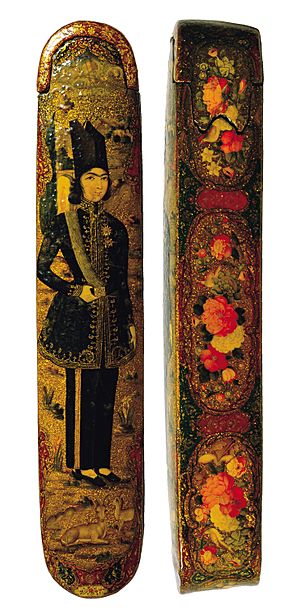
Sons
- Prince Soltan Mahmoud Mirza (1847–1849) Vali Ahad of Persia, 1849
- Prince Soltan Moin ed-Din Mirza (1849 – 6 November 1856) Vali Ahad of Persia, 1849–56
- Prince Soltan Massoud Mirza Zell os-Soltan (5 January 1850 – 2 July 1918)
- Prince Mohammad-Qassem Mirza (1850 – 29 June 1858) Vali Ahad of Persia, 1856-8
- Prince Soltan Hossein Mirza Jalal od-Dowleh (1852–1868)
- Prince Mozaffar ed-Din Mirza (25 March 1853 – 7 January 1907)
- Prince Kamran Mirza Nayeb os-Saltaneh (22 July 1856 – 15 April 1929)
- Prince Nosrat ed-Din Mirza Salar os-Saltaneh (2 May 1882 – 1954)
- Prince Mohammad-Reza Mirza Rokn os-Saltaneh (30 January 1884 – 8 July 1951)
- Prince Hossein-Ali Mirza Yamin od-Dowleh (1890–1952)
- Prince Ahmad Mirza Azd os-Saltaneh (1891–1939)
Daughters
- Princess Afsar od-Dowleh
- Princess Fakhr ol-Moluk (1847 – 9 April 1878)
- Princess Ismat al-Doulah (1855 – 3 September 1905)
- Princess Zi'a os-Saltaneh (1856 – 11 April 1898)
- Princess Fakhr od-Dowleh (1859–1891)
- Princess Forugh od-Dowleh (1862–1916)
- Princess Eftekhar os-Saltaneh (1880–1941)
- Princess Farah os-Saltaneh (1882 – 17 April 1899)
- Princess Tadj os-Saltaneh (1883 – 25 January 1936)
- Princess Ezz os-Saltaneh (1888–1982)
- Princess Sharafsaltaneh
Honours and Awards
Persian Awards
- Founder of the Imperial Order of the August Portrait, 1848
- Founder of the Decoration of the Commander of the Faithful, November 1856
- Founder of the Imperial Order of the Aqdas, 1870
- Founder of the Imperial Order of the Sun for Ladies, 1873
Foreign Awards
- Austrian Empire: Grand Cross of the Royal Hungarian Order of Saint Stephen, in Brilliants, 1859
- Grand Duchy of Baden:
- Knight of the House Order of Fidelity, 1889
- Knight of the Order of Berthold the First, 1889
- Kingdom of Bavaria: Knight of the Order of Saint Hubert, 1889
- Belgium: Grand Cordon of the Order of Leopold (military), 4 August 1857
- French Empire: Grand Cross of the Legion d'Honneur, 1855
- Kingdom of Italy:
- Knight of the Supreme Order of the Most Holy Annunciation, 13 April 1861
- Grand Cross of the Order of Saints Maurice and Lazarus, 1862
- Netherlands: Grand Cross of the Order of the Netherlands Lion, 1868
- Ottoman Empire:
- Order of Osmanieh, 1st Class, 1880
- Order of Glory, 1880
- Kingdom of Prussia:
- Knight of the Order of the Black Eagle, 12 January 1860; in Brilliants, 1873
- Grand Cross of the Order of the Red Eagle, in Brilliants, 9 June 1873
- Russian Empire:
- Knight of the Imperial Order of the White Eagle, 1838
- Knight of the Order of Saint Andrew the Apostle the First-called, 1873
- Knight of the Imperial Order of Saint Alexander Nevsky, 1873
- Knight of the Imperial Order of Saint Anna, 1st Class, 1873
- Knight of the Imperial Order of Saint Stanislaus, 1st Class, 1873
- Sweden-Norway: Knight of the Royal Order of the Seraphim, 7 March 1890
- United Kingdom: Stranger Knight of the Most Noble Order of the Garter, 26 June 1873
- Kingdom of Württemberg: Grand Cross of the Order of the Württemberg Crown, 1889
List of Prime Ministers
- Mirza Taqi Khan Amir Kabir (1848–1851)
- Mirza Aqa Khan-e Nuri (1851–1858)
- Position removed (1858–1871)
- Mirza Hosein Khan Moshir od-Dowleh Sepahsalar (1871–1873)
- Mirza Yousof Khan Ashtiani (1873–1880) (1st time)
- Prince Kamran Mirza (1880–1885)
- Mirza Yousof Khan Ashtiani (1885–1887) (2nd time)
- Mirza Ali-Asghar Khan Amin os-Soltan (1887–1896) (1st time)
Naser al-Din Shah in Fiction
- Naser al-Din Shah is played by Bahram Radan in the 2022 TV series Jeyran.
- He is shown in the 1976 TV series Soltan-e Sahebgharan and the 1984 TV series Amir Kabir.
- He also appears in the 1992 movie Nassereddin Shah, Actor-e Cinema (Once Upon a Time, Cinema). This film was written and directed by Mohsen Makhmalbaf. He is also in the 1984 film Kamal ol-Molk directed by Ali Hatami.
- He was the inspiration for the main character in the short story De koning (2002) and the novel De koning (2011). These were written by the Persian–Dutch writer Kader Abdolah.
- It is thought that Naser al-Din Shah is shown in the 1990 novel Phantom by Susan Kay. This book explores the life of the main character from Gaston Leroux's The Phantom of the Opera.
- His life was shown in an animation by Beate Petersen called Nasseredin Shah and his 84 wives in 2011.
- Joseph Roth wrote about him in his novel The tale of the 1002nd night (1939).
Images for kids
See also
- Amir Kabir
- Anglo-Persian War
- Attempts at Constitutionalization in Iran
- Austro-Hungarian Military Mission in Persia
- Bábi Movement
- Imperial Bank of Persia
- Jakob Eduard Polak
- Joseph Tholozan
- Naser al-Din Shah's slide
- Order of Aftab
- Persian Cossack Brigade
- Prix d'Ispahan
- Qajar family tree
- The Great Game
- Tobacco Protest
- Treaty of Paris
- Treaty of Akhal


